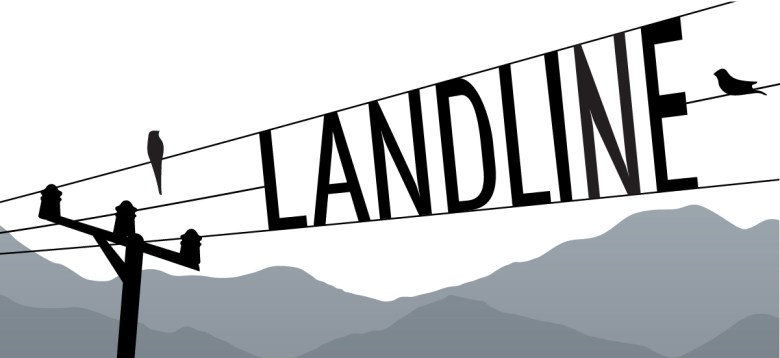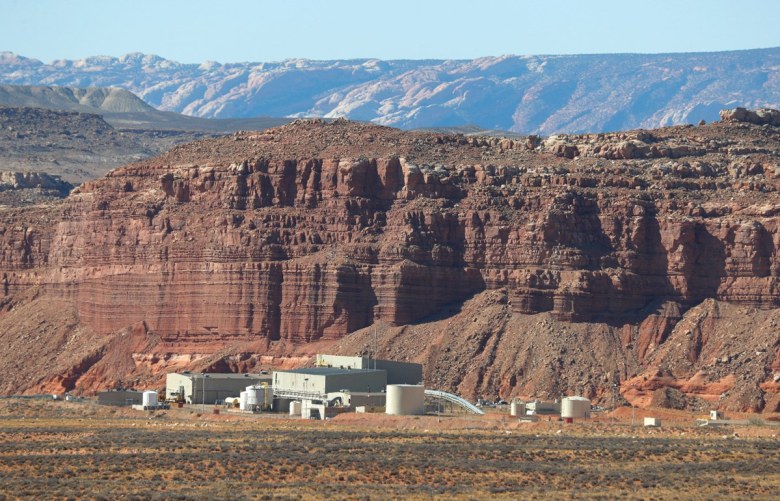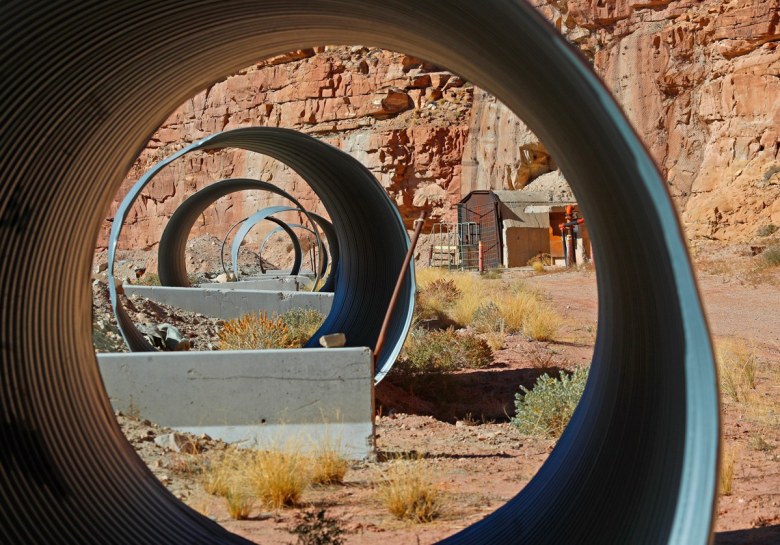
This is an installment of the Landline, a monthly newsletter from High Country News about land, water, wildlife, climate and conservation in the Western United States. Sign up to get it in your inbox.
In December, Canada-based Energy Fuels announced plans to begin production at three of its uranium mines, including the controversial Pinyon Plain (née Canyon) Mine, near the Grand Canyon, as well as two operations near Moab, Utah.
It seems like everywhere you look these days, some firm — maybe one with an unusual name (Okapi or Kraken, say) — is announcing that it’s acquiring or staking of thousands of acres of public-land mining claims, embarking on exploratory drilling or has “exciting,” if enigmatic, survey results to report. Does this mean that the long-moribund domestic uranium-mining industry is sauntering down the comeback trail?
It all brings back memories of Charlie Steen, the 31-year-old down-on-his-luck geologist who found pitchblende — i.e., high-grade uranium ore — on his Mi Vida claim in southeastern Utah in 1952.
Uranium was hot in Steen’s day. The nuclear arms race was already hurtling toward the backstretch, and the U.S. government was desperate to find domestic sources of fissionable material for its warheads. Several months prior to Steen’s strike, technicians in Idaho had whacked a uranium atom with a neutron and launched a chain reaction, generating electricity via nuclear fission for the first time and inspiring President Dwight D. Eisenhower to predict that nuclear energy would “serve the needs rather than the fears of the world — to make the deserts flourish, to warm the cold, to feed the hungry, to alleviate the misery of the world.”

Overnight, Steen’s Mi Vida find made him the region’s first “uraniumaire.” It also sparked a prospecting frenzy on the Colorado Plateau. Speculators staked 10-acre mining claims as if they were playing pieces in the popular board game Uranium Rush, spun them into mining companies with catchy names, and offered millions of shares of penny stocks to wide-eyed greenhorns. Ebony and The New Yorker ran ebullient pieces on wannabe prospectors flocking to Moab — where Steen set up shop. One New York auto dealer even equipped its cars with built-in Geiger counters so that motorists could “prospect as easily as they might go fishing.”
Today’s activity isn’t anywhere near that level, yet the conditions driving it evoke a certain sense of deja vu. Uranium spot prices are rising again, hitting a 17-year-high this week, and the feds are once again looking to secure domestic sources. Only now, instead of the Cold War, it’s fanned by Russia’s war on Ukraine; nearly all of America’s reactor fuel is imported, and a Russian company controls a good portion of global production. Eisenhower’s “atoms for peace” have become the climate hawks’ “atoms for carbon-reduction,” as they look to preserve aging reactors like California’s Diablo Canyon. And a gaggle of startups is scrambling to develop a new, smaller fleet of reactors that are purportedly more cost-effective and easier to build than the hulking and horrendously expensive giants of yesteryear.
All of this appears to be breathing life into the uranium industry, which in turn is filling my inbox with pumped-up press releases aimed at increasing the stock price from a few pennies to a few more pennies. While the Energy Fuels news is the biggest (it’s also readying additional mines for production), it seems like every firm has something to crow about. For example:
Uranium Energy says it is rebooting its Christensen Ranch in-situ recovery operation in Wyoming’s Powder River Basin.
Canada-based First American Uranium wants to do exploration work on its 26-claim Red Basin uranium/vanadium project on U.S. Forest Service land in Catron County, New Mexico.
Anfield Energy has been busy in the Four Corners Country in recent years, with purported plans to restart its Shootaring mill near Ticaboo, Utah, and to work on its parcels near Slickrock, Colorado. It also recently acquired claims in Utah’s San Juan and Grand Counties, as well as the Marquez and Juan Tafoya uranium projects north of Laguna Pueblo in New Mexico.
Consolidated Uranium claims it is beginning the process of reopening the long-idle Tony M Mine in the Shitamaring Creek drainage in southern Utah.
Uvre — which is a mining firm, not a pharmaceutical designed to treat male problems — says it has identified a five-kilometer uranium trend and anomaly at its East Canyon project north of Monticello, Utah.
Thor Energy says it has found high-grade uranium at its Wedding Bell and Radium Mountain projects on a mesa just east of the Dolores River in western Colorado.
Kraken Energy got the Bureau of Land Management’s go-ahead to drill on Harts Point, right along the northeast border of Bears Ears National Monument in Utah, and Consolidated Uranium reported successful drilling results at its Daneros Mine on the southern end of Bears Ears.
Australia-based Okapi Resources is set to begin exploratory drilling near Cañon City, Colorado, raising concerns among the locals.

Seeing this all in one place can be a bit alarming (or exciting, I suppose, if you’re one of those folks who mounts Geiger counters on your pickup). After all, many of these sites and their residents are still trying to heal the wounds inflicted by the Steen-era mining boom that ravaged landscapes and human lives until its demise in the 1980s. Worried about a repeat, the Havasupai Tribe and Navajo Nation continue to fight Energy Fuels’ Pinyon Plain operation, which sits within Baaj Nwaavjo I’tah Kukveni–Ancestral Footprints of the Grand Canyon National Monument. If even a fraction of the current proposals come to fruition, the land protectors could find themselves playing yet another game of whack-a-mole.
But mining history tells us that quite often a boom will go bust before the mining even starts. The last time uranium prices were this high was in 2007, when they spiked to $141 for a brief period, sparking a flurry of mining claims and proposals, property acquisitions and plans to reopen idled facilities. Someone even wanted to build a nuclear power plant in Green River, Utah. By 2008 prices had tumbled, and the industry struggled to scrub off the stain born of the Fukushima disaster in 2011. The “renaissance” fizzled. The Green River nuke plant plan petered out, and the domestic uranium mining industry entered a zombie-like state.
Already, the current hype is dimming somewhat. Oregon startup NuScale’s planned small modular reactor facility in Idaho was recently canceled — owing to rising costs — by the coalition of utilities that would have used its power. The U.S. military also revoked its contract with a California startup, Oklo, to build a micro-reactor at an Alaskan Air Force base. The Bill Gates-backed bid to replace a Wyoming coal plant with a reactor has encountered delays. And keep in mind that the current price increases are due not to existing demand or scarcity, but to anticipated demand — otherwise known as speculation. Last year’s U.S. uranium production was essentially zero, despite the high prices.
Even Steen’s boom faded. A handful of companies, including Steens’, stuck around and opened mines, built mills, churned up the ground and piled up toxic waste. But as soon as the prospectors and speculators realized that hitting a Mi Vida-like jackpot wasn’t quite as easy as catching a fish, most fled back whence they came. A nationally syndicated 1956 article noted that the wannabe uraniumaires had left Moab with a pile of debt, a bunch of new but empty motels and a stockpile of unsellable Geiger counters.
Still, all was not lost. One observer noted that at least the sudden influx of men had diversified the gene pool, saving Moab from becoming “the most inbred town in all of Utah.”
Your news tips, comments, ideas and feedback are appreciated and often shared. Give Jonathan a ring at the Landline, 970-648-4472, or send us an email at landline@hcn.org.
Jonathan Thompson is a contributing editor at High Country News. He is the author of Sagebrush Empire: How a Remote Utah County Became the Battlefront of American Public Lands.

